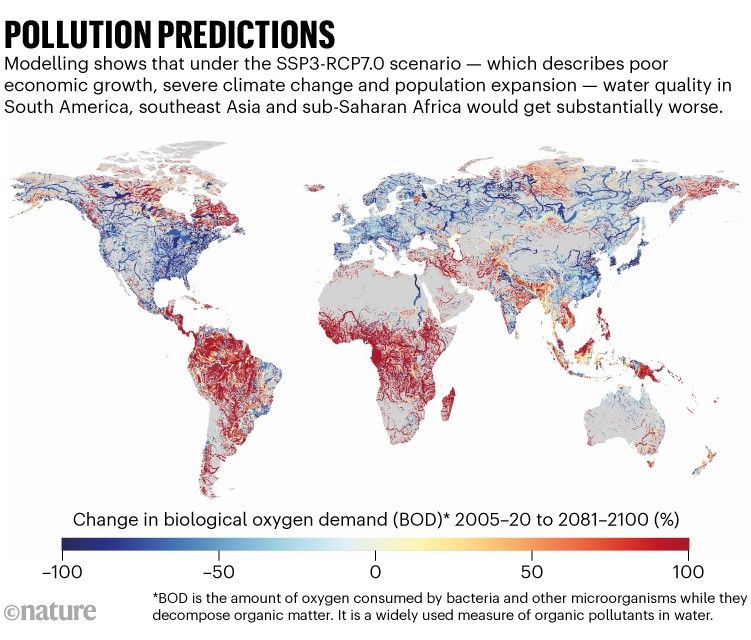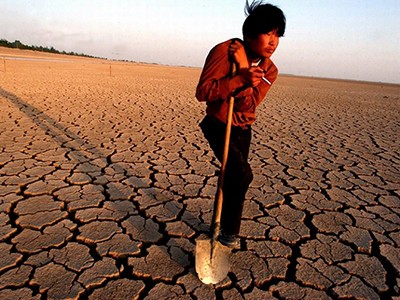Water pollution ‘timebomb’ threatens global health
Water pollution 'timebomb' threatens global health Nature.com


Exposure to Polluted Water: A Modelling Study
According to a recent modelling study, up to 5.5 billion people worldwide could be exposed to polluted water by 2100. The study examined surface water quality under different climate and socio-economic scenarios, revealing that sub-Saharan Africa would be among the most affected regions. These predictions, published in Nature Water on July 17, provide a comprehensive analysis of water quality in sub-Saharan Africa, shedding light on the urgent need for action.
Implications for Sustainable Development Goals (SDGs)
The Sustainable Development Goals (SDGs) aim to ensure access to clean water for all by 2030. However, the study’s findings highlight the significant challenges in achieving this goal. Without sufficient investment in water infrastructure and treatment, the world is facing a ticking time bomb. It is crucial to address this issue to prevent a global water crisis.
Source: Ref 1.

Water Quality Projections
The study utilized existing models of global water quality to forecast the future effects of climate change and socio-economic trends. Three climate scenarios, known as SSP1-RCP2.6, SSP5-RCP8.5, and SSP3-RCP7.0, were considered. These scenarios represent different pathways of greenhouse gas concentrations and societal factors. The results indicated that countries in South America and sub-Saharan Africa with emerging economies would experience worsening water quality. Wealthier nations, on the other hand, would see improvements in water treatment and a decrease in pollutants.
The water crisis is worsening. Researchers must tackle it together
The SSP3-RCP7.0 scenario, characterized by poor economic growth, severe climate change, and population expansion, presented the worst-case scenario. In this model, organic water pollution in sub-Saharan Africa would increase more than fourfold by 2100, leaving 1.5 billion people exposed to unsafe water. South Asia, the Middle East, and North Africa would also experience deteriorating water quality and increased pollution exposure.
It is worth noting that a ‘business-as-usual’ scenario, although unsustainable in terms of fossil fuel dependence, could lead to improved water infrastructure and quality. The study emphasizes the importance of addressing economic growth, climate change, and population expansion to prevent further deterioration of water quality.
A Global Effort for Clean Water
The research underscores the need for better implementation of regional water-quality policies. The SDGs call for universal access to safe drinking water by 2030, but there is a disconnect between global policies and local realities. A coordinated approach that prioritizes both people and the planet is essential. Pollution knows no boundaries, and cross-boundary collaborations will be crucial in averting the worst predictions.
SDGs, Targets, and Indicators
| SDGs | Targets | Indicators |
|---|---|---|
| SDG 6: Clean Water and Sanitation | Target 6.1: By 2030, achieve universal and equitable access to safe and affordable drinking water for all | Indicator not mentioned in the article |
| SDG 6: Clean Water and Sanitation | Target 6.3: By 2030, improve water quality by reducing pollution, eliminating dumping and minimizing release of hazardous chemicals and materials, halving the proportion of untreated wastewater, and increasing recycling and safe reuse globally | Indicator not mentioned in the article |
| SDG 13: Climate Action | Target 13.1: Strengthen resilience and adaptive capacity to climate-related hazards and natural disasters in all countries | Indicator not mentioned in the article |
| SDG 13: Climate Action | Target 13.3: Improve education, awareness-raising, and human and institutional capacity on climate change mitigation, adaptation, impact reduction, and early warning | Indicator not mentioned in the article |
| SDG 17: Partnerships for the Goals | Target 17.16: Enhance the global partnership for sustainable development, complemented by multi-stakeholder partnerships that mobilize and share knowledge, expertise, technology, and financial resources | Indicator not mentioned in the article |
1. Which SDGs are addressed or connected to the issues highlighted in the article?
SDG 6: Clean Water and Sanitation
The issue of polluted water and the need for access to safe drinking water are directly connected to SDG 6, which aims to ensure clean water and sanitation for all.
SDG 13: Climate Action
The article mentions future climate scenarios and their impact on water quality. This connects to SDG 13, which focuses on taking urgent action to combat climate change and its impacts.
SDG 17: Partnerships for the Goals
The need for cross-boundary collaborations to address water pollution is highlighted in the article. This aligns with SDG 17, which emphasizes the importance of partnerships to achieve sustainable development goals.
2. What specific targets under those SDGs can be identified based on the article’s content?
Target 6.1: By 2030, achieve universal and equitable access to safe and affordable drinking water for all
The article mentions that two billion people worldwide already struggle to access safe drinking water. This target aims to ensure that everyone has access to safe drinking water by 2030.
Target 6.3: By 2030, improve water quality by reducing pollution, eliminating dumping and minimizing release of hazardous chemicals and materials, halving the proportion of untreated wastewater, and increasing recycling and safe reuse globally
The article discusses the worsening water quality in certain regions due to pollution. This target focuses on improving water quality by reducing pollution and increasing recycling and safe reuse of water.
Target 13.1: Strengthen resilience and adaptive capacity to climate-related hazards and natural disasters in all countries
The article mentions future climate scenarios and their impact on water quality. This target aims to strengthen resilience and adaptive capacity to climate-related hazards, including those affecting water resources.
Target 13.3: Improve education, awareness-raising, and human and institutional capacity on climate change mitigation, adaptation, impact reduction, and early warning
The article emphasizes the need for better implementation of regional water-quality policies and joined-up approaches. This target focuses on improving education, awareness, and capacity on climate change mitigation and adaptation.
Target 17.16: Enhance the global partnership for sustainable development, complemented by multi-stakeholder partnerships that mobilize and share knowledge, expertise, technology, and financial resources
The article highlights the importance of cross-boundary collaborations to address water pollution. This target emphasizes the need for enhanced global partnerships and multi-stakeholder collaborations to achieve sustainable development goals.
3. Are there any indicators mentioned or implied in the article that can be used to measure progress towards the identified targets?
No specific indicators are mentioned or implied in the article that can be used to measure progress towards the identified targets. The article provides a general overview of the issues related to water pollution and the need for action.
SDGs, Targets, and Indicators
| SDGs | Targets | Indicators |
|---|---|---|
| SDG 6: Clean Water and Sanitation | Target 6.1: By 2030, achieve universal and equitable access to safe and affordable drinking water for all | Indicator not mentioned in the article |
| SDG 6: Clean Water and Sanitation | Target 6.3: By 2030, improve water quality by reducing pollution, eliminating dumping and minimizing release of hazardous chemicals and materials, halving the proportion of untreated wastewater, and increasing recycling and safe reuse globally | Indicator not mentioned in the article |
| SDG 13: Climate Action | Target 13.1: Strengthen resilience and adaptive capacity to climate-related hazards and natural disasters in all countries | Indicator not mentioned in the article |
| SDG 13: Climate Action | Target 13.3: Improve education, awareness-raising, and human and institutional capacity on climate change mitigation, adaptation, impact reduction, and early warning | Indicator not mentioned in the article |
| SDG 17: Partnerships for the Goals | Target 17.16: Enhance the global partnership for sustainable development, complemented by multi-stakeholder partnerships that mobilize and share knowledge, expertise,
Behold! This splendid article springs forth from the wellspring of knowledge, shaped by a wondrous proprietary AI technology that delved into a vast ocean of data, illuminating the path towards the Sustainable Development Goals. Remember that all rights are reserved by SDG Investors LLC, empowering us to champion progress together. Source: nature.com
Join us, as fellow seekers of change, on a transformative journey at https://sdgtalks.ai/welcome, where you can become a member and actively contribute to shaping a brighter future.
|









